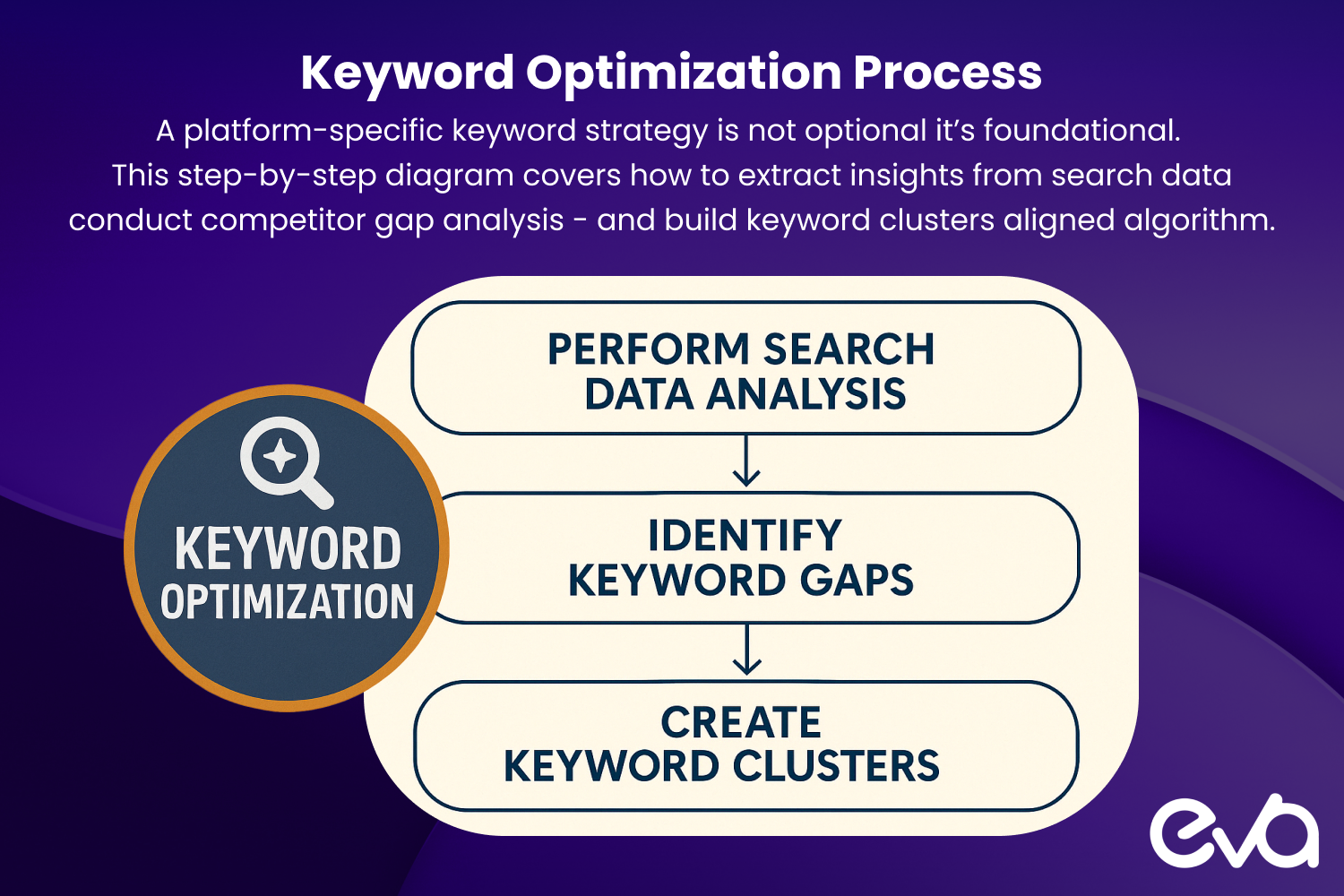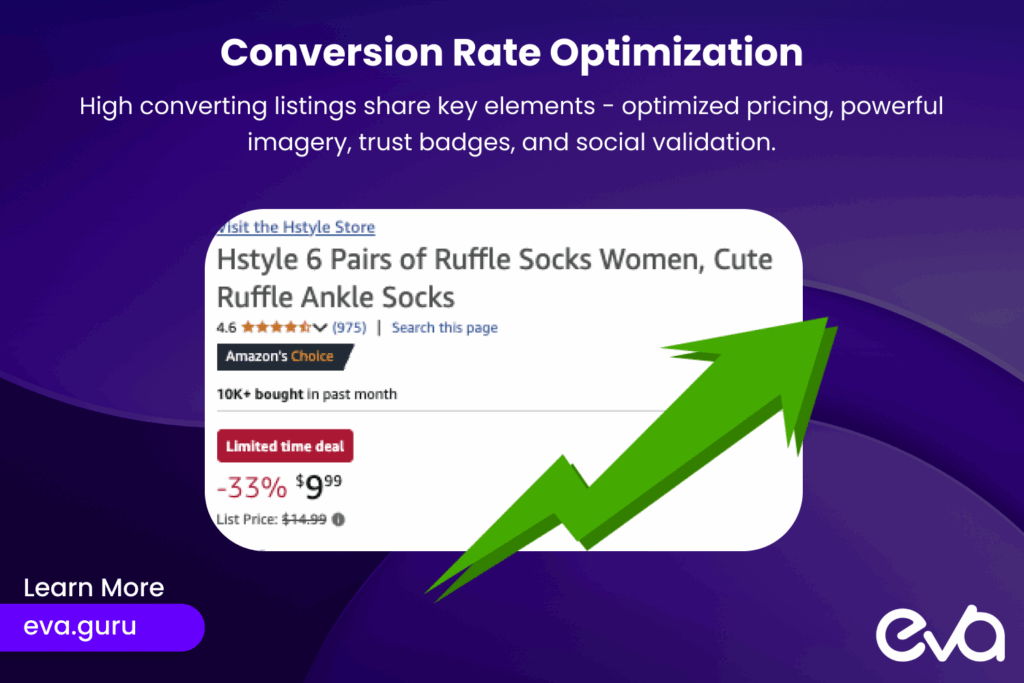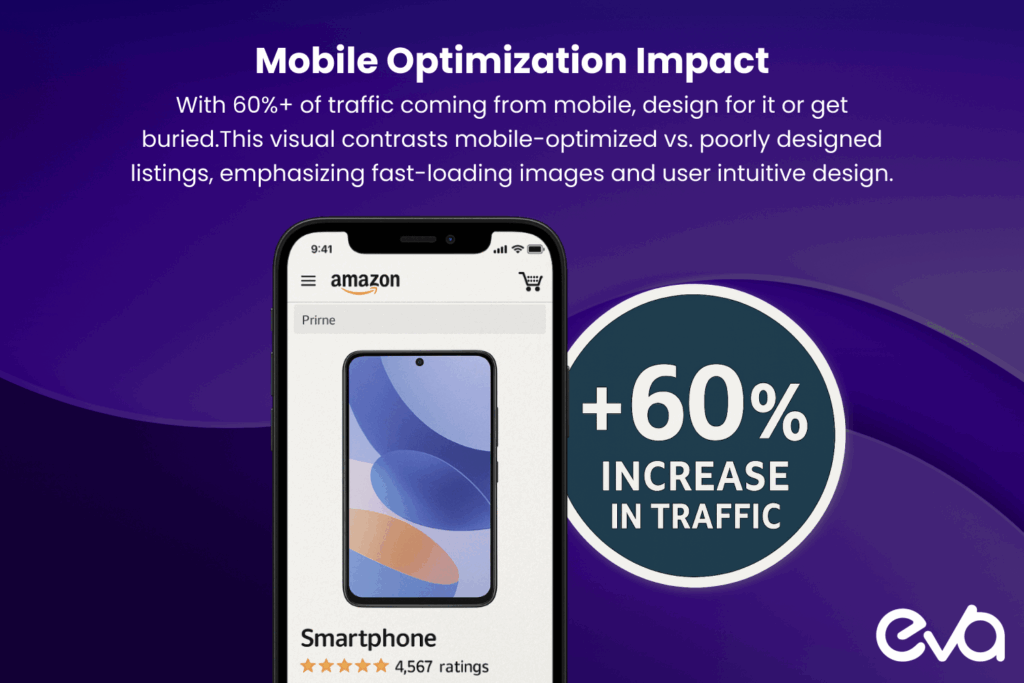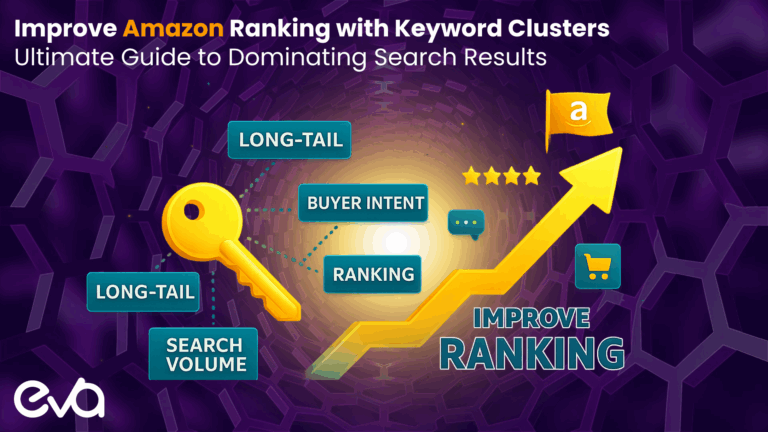Beyond basic optimization: Data-driven strategies to improve Amazon ranking, Walmart ranking, customer engagement, and conversion rates across all your e-commerce channels
Table of Contents
- Key Takeaways
- Understanding the E-commerce Ranking Ecosystem
- Strategic Keyword Optimization for Amazon SEO and Walmart SEO
- The Art and Science of Compelling Product Descriptions
- Leveraging Customer Reviews for Ranking Power
- Optimization for Click-Through and Conversion
- Competitive Analysis: Learning from Market Leaders
- Mobile Optimization: Essential for Modern E-commerce
- Cross-Platform Synergy: Building a Cohesive Ranking Strategy
- Advanced Schema Markup for Enhanced Visibility
- Continuous Optimization Through Analytics
- Frequently Asked Questions About E-commerce Product Rankings
- How Eva Can Transform Your Product Ranking Strategy
Key Takeaways
- Learn proven keyword optimization techniques specific to Amazon SEO and Walmart SEO
- Discover how customer reviews impact product visibility and Amazon ranking
- Understand the critical relationship between CTR, conversion rates, and Walmart ranking
- Master competitive analysis strategies to identify ranking opportunities on both platforms
- Implement mobile optimization techniques that boost both rankings and sales
- Explore how Eva’s human-centered approach can transform your product visibility
In today’s hypercompetitive e-commerce landscape, visibility is currency. With millions of products competing for attention across platforms like Amazon and Walmart, your Amazon ranking and Walmart ranking can make the difference between thriving and merely surviving.
This comprehensive guide explores proven techniques for improving product rankings through strategic Amazon SEO, Walmart SEO, and merchandising tactics that align with how search algorithms work in 2025.
Whether you’re launching new products or revitalizing existing listings, these strategies will help you navigate the complex world of e-commerce search optimization and achieve sustainable visibility that drives consistent sales.
Understanding the E-commerce Ranking Ecosystem
Before diving into tactics, it’s essential to understand how e-commerce ranking systems actually work. Product rankings determine where items appear when customers search on platforms or external search engines, with several interconnected factors influencing these positions.
Critical Ranking Factors Across Major Platforms

The primary elements affecting Amazon ranking and Walmart ranking include:
- Keyword relevance and optimization
- Listing completeness and quality
- Customer reviews (quantity, recency, and sentiment)
- Click-through rates (CTR)
- Conversion performance
- Sales velocity and history
- Inventory levels and fulfillment options
While the exact weighting of these factors varies by platform, mastering them collectively creates a foundation for sustainable ranking improvements across all marketplaces.
Strategic Keyword Optimization for Amazon SEO and Walmart SEO

Effective keyword strategy forms the backbone of product visibility. Unlike general SEO, Amazon SEO and Walmart SEO require platform-specific approaches that align with how customers actually shop on these marketplaces.
Research Methods That Deliver Results
Begin by identifying the search terms your ideal customers use when looking for products like yours:
- Platform-specific search data: Utilize tools like Amazon’s Brand Analytics for Amazon SEO or Walmart Keyword Research for Walmart SEO to uncover actual customer search behavior within each ecosystem.
- Traditional keyword research: Supplement platform data with insights from tools like Google Keyword Planner, Ahrefs, or SEMrush to identify broader search patterns and potential gaps.
- Competitor analysis: Study top-performing listings in your category to identify the keywords driving their Amazon ranking and Walmart ranking success.
Strategic Keyword Placement
Once you’ve identified your target keywords, strategic placement becomes crucial for both Amazon SEO and Walmart SEO:
- Product titles: Front-load with primary keywords while maintaining readability and including critical attributes. For example, instead of simply “Wireless Earbuds,” use “Bluetooth Wireless Earbuds with Active Noise Cancellation & 36-Hour Battery Life.”
- Bullet points: Structure bullets to highlight key features while incorporating secondary keywords naturally.
- Product descriptions: Weave in long tail keywords and semantic variations while telling a compelling product story.
- Backend/hidden fields: Utilize platform-specific hidden fields (like Amazon’s search terms) for additional keyword coverage without cluttering customer-facing content.
The Art and Science of Compelling Product Descriptions
Product descriptions serve dual masters: algorithms and human shoppers. Effective descriptions satisfy both by combining strategic keyword usage with persuasive copy that addresses customer needs.
Structure for Success
Format descriptions with both scanners and readers in mind:
- Feature-benefit pairing: For each feature, explicitly state the benefit it provides. For example: “Advanced noise-cancellation technology (feature) allows you to focus without distractions even in busy environments (benefit).”
- Problem-solution framing: Identify the problems your customers face and position your product as the solution.
- Sensory language: Use descriptive terms that help customers imagine using the product.
- Scannable formatting: Utilize short paragraphs, bullets, and strategic bolding to improve readability and boost your Amazon ranking and Walmart ranking.
Leveraging Customer Reviews for Ranking Power
Customer reviews influence Amazon ranking and Walmart ranking both directly (as a ranking signal) and indirectly (by improving conversion rates). A strategic approach to generating and managing reviews can significantly boost visibility.
Review Generation Strategies

Implement systematic approaches to encourage authentic reviews:
- Post-purchase email sequences: Create thoughtfully timed follow-up emails requesting feedback.
- Package inserts: Include physical reminders or QR codes in shipments that direct customers to review pages. (Pay close attention to Amazon and Walmart’s policies regarding inserts)
- Review incentives: Where platform policies allow, offer small discounts or loyalty points for leaving honest reviews.
Review Management Best Practices
- Prompt response: Address all negative reviews within 24 hours, demonstrating accountability and customer care.
- Identify patterns: Analyze reviews regularly to spot product issues or recurring customer confusion that might be hurting your Amazon ranking or Walmart ranking.
- Feature reviews: Highlight helpful reviews by marking them as such, increasing their visibility and impact.
Optimization for Click-Through and Conversion
Search algorithms for both Amazon SEO and Walmart SEO increasingly prioritize user engagement metrics when determining rankings. Products that attract clicks and convert well typically receive ranking boosts over time.
CTR Optimization Techniques
- Strategic image selection: Lead with the most compelling product image that clearly communicates value at thumbnail size.
- A/B test titles: Most platforms don’t offer native A/B testing, but you can manually rotate variations to identify which formulations drive higher clicks.
- Promotional badges: Utilize platform-specific promotional tags (like “Limited Time Offer” or “Sale”) to make listings stand out in search results.
Conversion Rate Improvement

- Price positioning: Analyze your competitive set to find the optimal price point that balances profit margins with conversion potential.
- Social proof elements: Prominently feature review counts, ratings, and certification badges.
- Fear of missing out (FOMO): Where appropriate, indicate limited availability or time-sensitive offers.
Competitive Analysis: Learning from Market Leaders
Understanding competitor strategies provides valuable insights for your own Amazon SEO and Walmart SEO optimization efforts.
Effective Competitive Research Methods
- Systematic ranking tracking: Monitor how your products and competitors rank for target keywords over time, noting which changes correlate with Amazon ranking and Walmart ranking improvements.
- Content gap analysis: Identify keywords competitors rank for that your listings don’t, revealing potential optimization opportunities.
- Listing structure comparison: Examine how top-performing competitors structure their titles, bullets, and descriptions to inform your own formatting decisions.
Mobile Optimization: Essential for Modern E-commerce

With over 70% of e-commerce traffic coming from mobile devices, optimizing for mobile users directly impacts Amazon ranking, Walmart ranking, and conversions.
Mobile-First Listing Strategies
- Front load critical information: Ensure the most important details appear first in titles and descriptions, as mobile displays show less content before requiring scrolling.
- Image optimization: Test product images on multiple devices to ensure clarity and impact at smaller sizes.
- Touch-friendly elements: For your own website, ensure all interactive elements are easily tappable on small screens.
- Speed optimization: Compress images and minimize code to improve load times, a critical factor in both rankings and conversions.
Cross-Platform Synergy: Building a Cohesive Ranking Strategy
Many sellers operate across multiple platforms, creating opportunities for synergistic optimization approaches between Amazon SEO and Walmart SEO.
Multi-Platform Optimization Techniques
- Content repurposing: Adapt high-performing content from one platform for use on others, maintaining consistent messaging while respecting platform-specific requirements.
- Unified keyword strategy: Develop a master keyword list that addresses search patterns across all platforms, then customize applications for each marketplace.
- Cross-platform traffic driving: Leverage your best-performing platform to drive traffic to listings on emerging channels.
Advanced Schema Markup for Enhanced Visibility
For independent e-commerce sites, implementing schema markup can generate rich snippets in search results, significantly improving CTR and indirectly boosting Amazon ranking and Walmart ranking when sending traffic to these platforms.
Implementation Approaches
- Product markup: Include pricing, availability, reviews, and other critical product information in structured data.
- Organization markup: Add company information to build credibility in search results.
- FAQ markup: If your product pages include frequently asked questions, mark them up to potentially appear in Google’s rich results.
Continuous Optimization Through Analytics
Successful Amazon SEO and Walmart SEO require ongoing analysis and refinement based on performance data.
Essential Metrics to Monitor
- Keyword ranking position: Track your Amazon ranking and Walmart ranking for target keywords over time.
- Impression-to-click ratio: Measure how often users click your listing after seeing it in search results.
- Session-to-purchase rate: Calculate how frequently visits convert to sales.
- Sell-through rate: Monitor how quickly inventory sells relative to comparable products.
Testing Methodologies
- Controlled testing: Change one element at a time to clearly identify which modifications impact Amazon ranking and Walmart ranking.
- Seasonal adjustments: Adapt strategies to align with seasonal search patterns and buying behaviors.
- Competitive benchmarking: Regularly compare your metrics against category averages and top performers.
Frequently Asked Questions About E-commerce Product Rankings
How quickly can I expect to see ranking improvements after optimizing my listings?
Ranking improvements for Amazon SEO and Walmart SEO typically follow a non-linear pattern. Initial changes may be visible within 2-4 weeks, but meaningful, stable improvements often take 2-3 months of consistent optimization and performance. Focus on steady progress rather than dramatic overnight changes, which tend to be unsustainable.
Do paid promotions and advertising affect organic product rankings?
While most platforms maintain separation between paid and organic rankings, advertising indirectly impacts organic Amazon ranking and Walmart ranking by increasing sales velocity, review volume, and engagement metrics – all factors in organic ranking algorithms. Strategic advertising can create a positive feedback loop that enhances organic visibility over time.
How important is pricing in product ranking algorithms?
Pricing affects Amazon ranking and Walmart ranking primarily through its impact on conversion rates rather than as a direct ranking factor. While being the lowest-priced option isn’t necessary, significant price outliers (much higher than comparable options) typically see reduced click-through and conversion rates, indirectly hurting rankings.
Should I prioritize optimizing new or existing products?
Focus optimization efforts on products with the highest potential return. This typically includes:
- High-margin items with significant profit potential
- Products with established sales history but declining visibility
- Seasonal items approaching their peak demand period
- New products in categories where you have established seller credibility
How do I optimize for voice search on e-commerce platforms?
Voice search optimization for Amazon SEO and Walmart SEO requires focusing on conversational, question-based queries. Include natural language patterns in your backend keywords, emphasize long-tail keyword phrases, and structure Q&A sections to mirror how people verbally ask about products.
What role does inventory management play in product rankings?
Consistent inventory availability positively impacts Amazon ranking and Walmart ranking across most platforms. Frequent out-of-stock situations signal unreliability to algorithms and customers alike, potentially lowering visibility even when the product returns to stock. Maintain adequate inventory levels, especially for best-selling items.
How Eva Can Transform Your Product Ranking Strategy
At Eva, we believe effective Amazon SEO and Walmart SEO require both technical precision and authentic human connection. Our unique approach combines data-driven methodology with storytelling expertise to create listings that resonate with both algorithms and shoppers.
Eva’s Human-Centered Ranking Methodology
Our team specializes in transforming technical product information into compelling narratives that drive engagement and conversion through:
Authentic Storytelling Optimization
- We craft product descriptions that weave keywords seamlessly into emotionally resonant narratives, creating the perfect balance between search visibility and persuasive selling.
Conversion-Focused Imagery Direction
- Our visual specialists guide product photography and image selection to ensure every visual element works harmoniously to improve both click-through rates and conversion.
Review Cultivation Programs
- We design customized review generation strategies that ethically maximize authentic customer feedback, building social proof while strengthening Amazon ranking and Walmart ranking signals.
Competitive Gap Analysis
- Our proprietary analysis methodology identifies specific ranking opportunities by uncovering weaknesses in competitor listings that your products can address.
Platform-Specific Optimization
- With specialists dedicated to Amazon SEO, Walmart SEO, and other major platforms, we create tailored strategies that leverage the unique ranking factors of each marketplace.
The Eva Difference
While many agencies approach e-commerce optimization purely as a technical exercise, Eva recognizes that lasting ranking success comes from creating genuine connections with customers. Our strategies go beyond keyword stuffing to build product stories that engage, persuade, and convert.
By combining data analytics with human creativity, we develop optimization approaches that not only improve initial visibility but create the engagement signals that lead to sustained Amazon ranking and Walmart ranking success.
Ready to transform your product visibility with strategies that work in today’s competitive landscape? Contact the Eva team to discuss how our human-centered approach can elevate your product rankings and drive sustainable sales growth across all your e-commerce channels.








